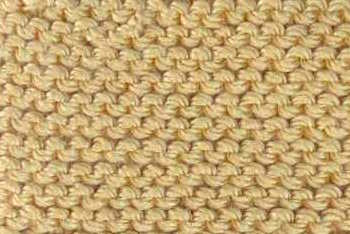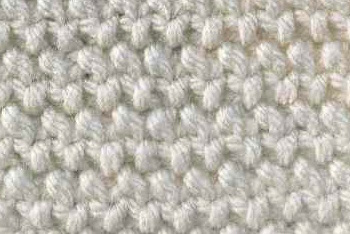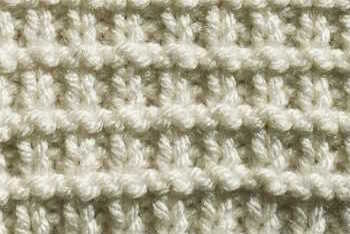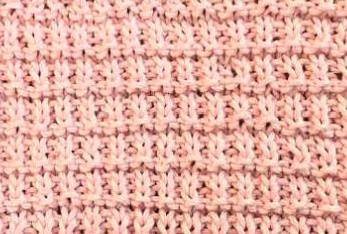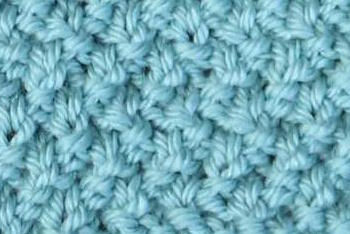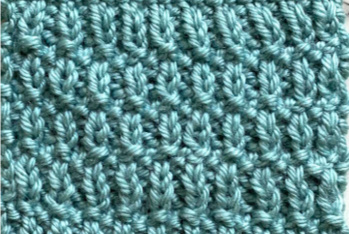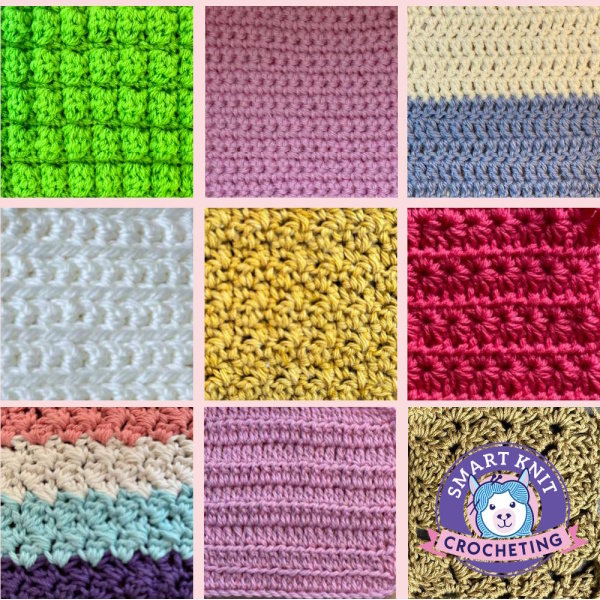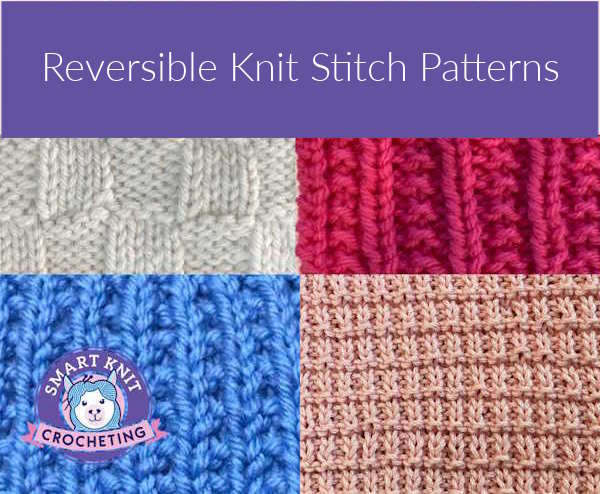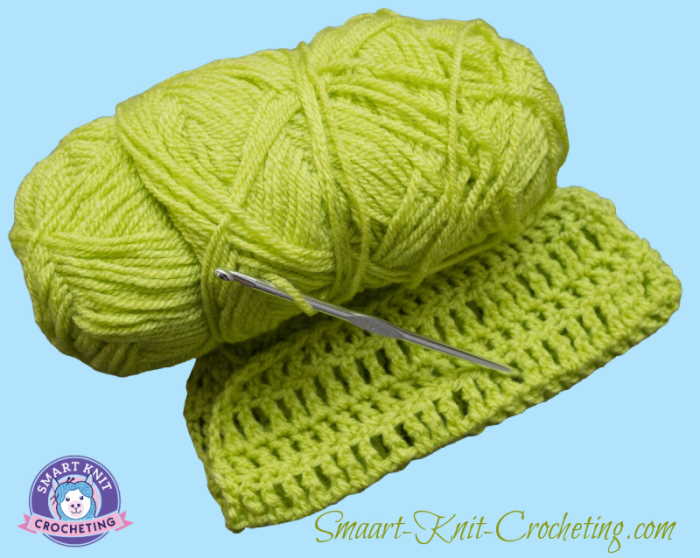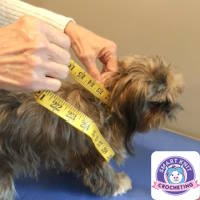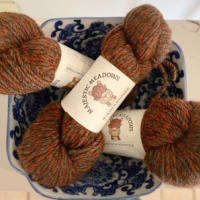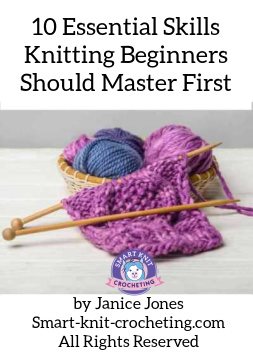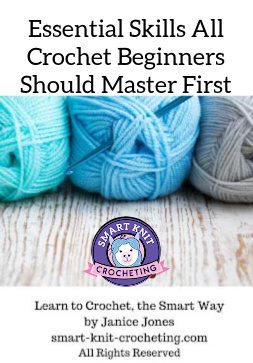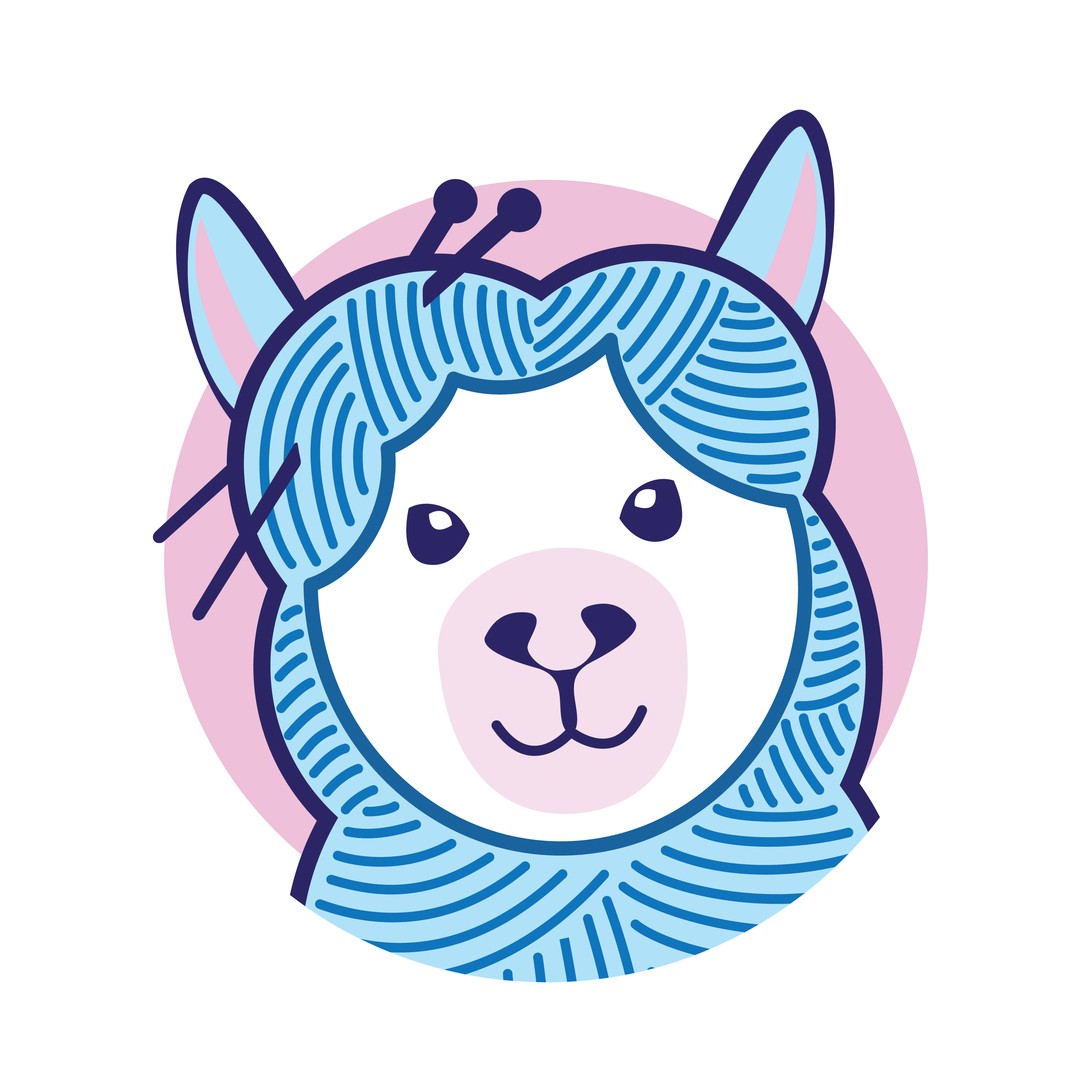- Home
- Easy Beginner Knit Projects
- Knitting Blankets for Beginners
Knitting Blankets for Beginners: Ultimate Guide
Knitting Blankets for Beginners
by Janice Jones
October 2025
If you’re starting out with knitting, a blanket is one of the best beginner projects you can choose. It’s simple, relaxing, and incredibly rewarding. You can practice your knitting techniques (English or Continental Knitting), improve your tension, and learn an easy stitch pattern all without worrying about shaping, sizing, or complex stitch patterns.
With just a few basic supplies and the knit stitch, you can create something warm, cozy, and completely handmade. Whether you’re knitting for yourself, a loved one, or as a first big project, this guide will walk you through every step of how to knit a blanket from start to finish.
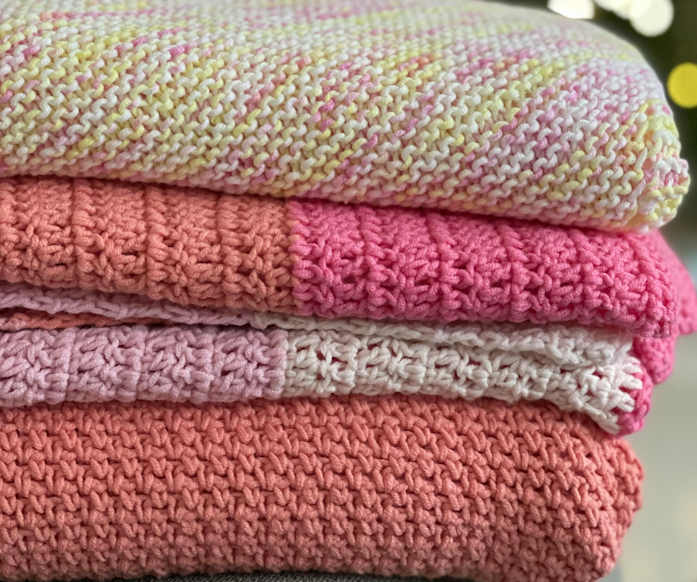
In this tutorial, you’ll learn how to choose the right yarn and needles, master the basic stitches, and follow easy, beginner-friendly patterns that anyone can complete.
We’ll cover essential tips for measuring your blanket, estimating the number of stitches to cast on, and adding beautiful finishing touches, such as borders or fringe. By the end, you’ll not only have your first knitted blanket, but you’ll also have the confidence to take on even bigger projects. Let’s get those needles clicking!
Tools and Materials for Your First Blanket
- Yarn weight suggestions (bulky, medium, Look for CKC # 4 or #5 Weights)
- Yarn Fibers: Choose a washable acrylic, acrylic/wool blend, or a superwash Wool Yarn.
- Needle size will depend on the weight of the yarn you choose. For worsted-weight (CKC #4) yarn, the recommended needle size is US 7 (4.5 mm) or US 8 (5.0 mm). I might suggest going up one or two needle sizes for a blanket that has a nice drape. If you choose to use a bulky yarn (CKC #5), the size recommendations are US 9 to 11 (5.5 to 8 mm). Again, going up a needle size or two is a good idea.
- Needle Type: Circular needles with long cables. You will be working flat and not in the round, but circular needles will hold more stitches. Needles made with wood or bamboo are ideal for beginners.
- Stitch markers, tapestry needle, scissors.
Learn the Simple Stitches First
- Knit stitch: Learn how to make the Knit Stitch.
- Purl Stitch: Learn how to make the Purl Stitch
- Cast-on: Learn how to cast on using the Longtail Cast-on Method
- Bind off: Learn how to bind off.
- Weave in Ends: Learn how to weave in ends.
How to Knit a Blanket Step by Step
Here is a checklist for you to use to create your first blanket:
- I have decided what type of yarn I want to use.
- I have found the corresponding circular needles in the appropriate size.
- I know what kind of blanket I want to make.
- I chose the stitch pattern to use and understand why I made that selection.
- I have made a swatch and calculated the gauge.
- I know how many stitches to cast on and have cast on the appropriate number.
- I have begun the blanket.
- I have knit the number of rows needed for the size of my blanket.
- I have cast off and blocked my project.
- Weaving in my tails, I have completed my blanket.
- I've shared my blanket on this site and with the world.
1. Choose Yarn and Needles.
If you are unsure about knitting needles and types of yarn, I suggest checking out a couple of resources first.
Knitting Needles and/or Guide to Interchangeable Knitting Needles
| US Needle Size | Metric Size (mm) | Recommended Yarn Weight | Typical Gauge (stitches per inch) | Typical Gauge (stitches per 4 in / 10 cm) | Notes |
|---|---|---|---|---|---|
| 7 | 4.5 mm | Light Worsted / DK (Weight 3–4) | 5 – 5.5 | 20 – 22 | Good for lighter blankets and garments with drape. |
| 8 | 5.0 mm | Worsted / Medium (Weight 4) | 4.5 – 5 | 18 – 20 | Most common beginner size; pairs well with medium yarn. |
| 9 | 5.5 mm | Worsted / Aran (Weight 4–5) | 4 – 4.5 | 16 – 18 | Great for chunky throws and textured stitches. |
| 10 | 6.0 mm | Bulky (Weight 5) | 3.5 – 4 | 14 – 16 | Produces cozy, thick fabric — ideal for throws and lapghans. |
| 10½ | 6.5 mm | Bulky (Weight 5) | 3 – 3.5 | 12 – 14 | Looser gauge; creates soft, drapey blankets. |
| 11 | 8.0 mm | Bulky / Chunky (Weight 5–6) | 2.75 – 3 | 11 – 12 | Fast to knit; great for thick, warm blankets. |
| 13 | 9.0 mm | Super Bulky (Weight 6) | 2 – 2.5 | 8 – 10 | Very large stitches; ideal for chunky knit blankets. |
EXAMPLE
1. I have chosen to use Patons Classic Wool Yarn
2. I like wooden needles so that I will use Knit Picks Circular Needles.
3. The Yarn ball recommends size 7 (4.5 mm) needles.
4. I want my blanket to have a nice drape, so I'm going up two needle sizes.
5. I will use a size US 9 with a 32" cable
Use this chart to estimate how much yarn you’ll need for your next blanket project. It’s always better to buy an extra skein, especially if your yarn has dye lots.
To use this chart,
- Determine the type of blanket you will make. A baby blanket is typically a manageable project for beginners.
- Determine the type of yarn you are using (either #4 or #5).
- Refer to the chart to determine the length of yarn you will need.
- Look at the yarn ball band to determine the length of yarn within the skein.
- Divide the total amount of yarn needed (from the chart) by the yarn length contained in your yarn skein. This will determine the number of skeins you will need to buy.
- Round up to the following whole number.
- Add one skein in the same dye lot.
Information Found on the Ball Band
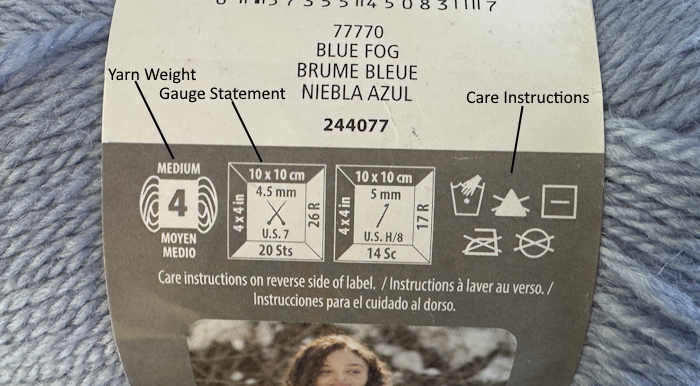 You can locate the yarn weight, estimated gauge, recommended knitting needles, and care symbols.
You can locate the yarn weight, estimated gauge, recommended knitting needles, and care symbols.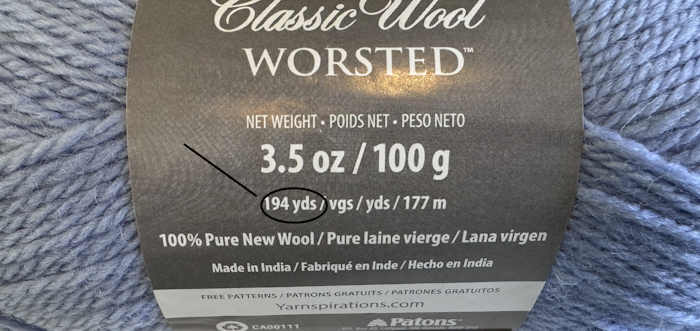 On the front of this ball band, I was able to determine that there are 194 yards of yarn on this skein.
On the front of this ball band, I was able to determine that there are 194 yards of yarn on this skein.EXAMPLE
1. I want to make a baby blanket.
2. I want to use Patons Classic Wool Worsted*
3. I need 700 to 900 yards of yarn.
4. Each skein of my yarn contains 194 yds.
5. I divided 900 yards by 194 yards and got 4.63.
6. This means I need five skeins plus one more, or six skeins total.
*I don't recommend making a baby blanket with a 100% wool yarn. It is not machine washable, and you don't know whether the baby might have an allergy. I chose this yarn specifically because I have a large quantity of it in my stash, and my dogs will love the blanket!
| Blanket Type | Approx. Dimensions (in) | Yarn Weight | Approx. Yarn Needed (yards) | Approx. Yarn Needed (meters) | Notes |
|---|---|---|---|---|---|
| Baby Blanket | 30 × 35 | Medium (4) | 700 – 900 | 640 – 820 | Soft, washable yarn (acrylic or cotton blend). |
| Lapghan / Lap Blanket | 35 × 40 | Medium (4) | 900 – 1,100 | 820 – 1,000 | Perfect size for learning; manageable length. |
| Throw Blanket | 50 × 60 | Medium (4) | 1,200 – 1,800 | 1,100 – 1,650 | Most popular beginner size; cozy sofa blanket. |
| Twin Blanket | 65 × 90 | Medium (4) | 2,000 – 2,500 | 1,830 – 2,290 | Use circular needles to support blanket weight. |
| Full / Double Blanket | 80 × 90 | Medium (4) | 2,800 – 3,500 | 2,560 – 3,200 | Light yarn helps reduce total weight and cost. |
| Queen Blanket | 90 × 100 | Medium (4) | 3,500 – 4,000 | 3,200 – 3,650 | Large project; plan multiple skeins from same dye lot. |
| King Blanket | 108 × 100 | Medium (4) | 4,500 – 5,000 | 4,100 – 4,570 | Use circular needles and lightweight yarn to manage size. |
| Throw Blanket (Chunky Yarn) | 50 × 60 | Bulky (5) | 900 – 1,100 | 820 – 1,000 | Chunky yarn knits up fast with fewer yards needed. |
| Queen Blanket (Chunky Yarn) | 90 × 100 | Bulky (5) | 2,800 – 3,200 | 2,560 – 2,930 | Great for warm, quick projects using large needles. |
3. Choose the type of Blanket to make
Review the Chart Below.
| Blanket Type | Typical Dimensions (inches) | Typical Dimensions (cm) | Notes for Knitters |
|---|---|---|---|
| Baby Blanket | 30 × 35 | 76 × 89 | Small, fast to knit—ideal first project. Use soft, washable yarn (cotton or acrylic). |
| Lapghan / Lap Blanket | 35 × 40 | 89 × 102 | Manageable size and great for gifting. |
| Crib Blanket | 36 × 45 | 91 × 114 | Slightly larger than baby blanket—fits a standard crib. |
| Throw Blanket | 50 × 60 | 127 × 152 | Common sofa/reading blanket; popular beginner goal. |
| Twin Blanket | 65 × 90 | 165 × 229 | More yarn/patience required; still manageable. |
| Full / Double Blanket | 80 × 90 | 203 × 229 | Consider lighter yarn or larger needles to finish faster. |
| Queen Blanket | 90 × 100 | 229 × 254 | Big project—circular needles help distribute weight. |
| King Blanket | 108 × 100 | 274 × 254 | Very large—best for experienced beginners/advanced. |
4. Choose a Stitch Pattern
Here are a couple of easy reversible stitch patterns suitable for beginners.
EXAMPLE
I've learned how to make knit and purl stitches. I want to practice these skills, but I want to focus on the garter pattern to hone my knitting skills using both the English and Continental methods, thereby improving my tension.
- I've chosen to make my blanket with the garter stitch pattern.
5. Make a Gauge Swatch
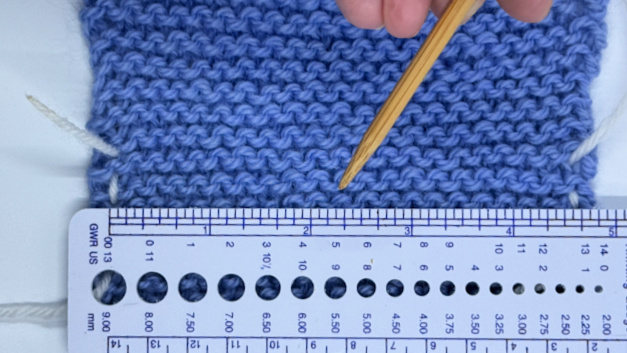
Knitting gauge refers to the number of stitches and rows a knitter produces in a 4-inch (or 10-centimeter) square of fabric, which determines the final size and fit of a project.
Gauge is critical when you want something you make to fit, such as a hat or a sweater. It is not as important when making a blanket, but since this is a beginner tutorial, I would be amiss not to mention it. Read more about how to calculate gauge in knitting.
To create a gauge swatch, ensure it is larger than the 4 x 4 inch (10 x 10 cm) required for the calculations. I recommend making a swatch that is 5 x 5 inches. But how many stitches should you cast-on?
Scroll back up to the table, Knitting Needle Sizes and Recommended Gauges.
Based on my hypothetical example, I'm using a worsted-weight yarn (CKC #4). The chart suggests that I use size 7 or 8 needles, which would indicate that I will achieve a gauge of 18 to 22 stitches per four-inch square. If I use 7- or 8-inch needles, I should cast on more than 22 stitches to create my swatch.
However, I decided to use a size 9 needle. Again, I look at the chart and find out that I should get 16 to 18 stitches per 4 inches. Therefore, I will cast-on more than 18 to make my swatch. I will cast on 22 stitches and work in the garter stitch pattern.
| US Needle Size | Metric Size (mm) | Recommended Yarn Weight | Typical Gauge (stitches per inch) | Typical Gauge (stitches per 4 in / 10 cm) | Notes |
|---|---|---|---|---|---|
| 7 | 4.5 mm | Light Worsted / DK (Weight 3–4) | 5 – 5.5 | 20 – 22 | Good for lighter blankets and garments with drape. |
| 8 | 5.0 mm | Worsted / Medium (Weight 4) | 4.5 – 5 | 18 – 20 | Most common beginner size; pairs well with medium yarn. |
| 9 | 5.5 mm | Worsted / Aran (Weight 4–5) | 4 – 4.5 | 16 – 18 | Great for chunky throws and textured stitches. |
| 10 | 6.0 mm | Bulky (Weight 5) | 3.5 – 4 | 14 – 16 | Produces cozy, thick fabric — ideal for throws and lapghans. |
| 10½ | 6.5 mm | Bulky (Weight 5) | 3 – 3.5 | 12 – 14 | Looser gauge; creates soft, drapey blankets. |
| 11 | 8.0 mm | Bulky / Chunky (Weight 5–6) | 2.75 – 3 | 11 – 12 | Fast to knit; great for thick, warm blankets. |
| 13 | 9.0 mm | Super Bulky (Weight 6) | 2 – 2.5 | 8 – 10 | Very large stitches; ideal for chunky knit blankets. |
Once you understand the process, knit a swatch that measures approximately 5 inches by 5 inches using the instructions above. Then do the calculations.
CALCULATIONS
1. Use scrap yarn or stitch markers to mark off where you will do your gauge measurements. Do not include bind-off or cast-on edge stitches or stitches on either side of the fabric. Measure to within 1/8" then convert to a decimal. For example 1/8" =.125, 1/4 = .25, 3/8: = .375, 1/2 = .5, 5/8" = .625
2. Count the number of stitches within the space you marked off.
3. Divide the number of stitches by the width you calculated in number 1, but don't round.
4. Multiply the number you got in #3 by 4 and round up or down.
EXAMPLE
1. Measurement is 4.5 inches or 4.5
2. There are 19 sts.
3. 19/4.5 = 4.22
4. 4.22 x 4 =16.88 or 17.0
4 inches = 17 stitches
1 inch ~ 4 stitches
6. Cast-on the Stitches
 Place a stitch marker every 20 stitches to help keep track of your count.
Place a stitch marker every 20 stitches to help keep track of your count.Use the long-tail cast-on method to place the correct number of stitches onto the needle, as indicated in the chart below.
I am making a baby blanket, and the chart tells me that a baby blanket is 30 inches wide. I found out that my gauge is 17 stitches per four inches, or approximately four stitches per inch. I multiply 4 x 30 = 120 stitches.
Therefore, I will cast on 120 stitches using circular needles, but I will not connect to work in the round. I will be using the long cable on the circular needle to hold all the stitches.
*This is a rough estimate. If I were making a sweater, my calculations might be a little closer.
| Blanket Type | Approx. Width (in) | Yarn Weight | Typical Gauge (stitches/in) | Estimated Cast-On Stitches | Notes / Tips |
|---|---|---|---|---|---|
| Baby Blanket | 30 | Bulky (5) | 3 | 90 | Soft yarn (acrylic/cotton blend). Quick knit. |
| Baby Blanket | 30 | Medium (4) | 4.5 | 135 | Warm and cozy; manageable size. |
| Lapghan / Lap | 35 | Bulky (5) | 3 | 105 | Great practice project. |
| Lapghan / Lap | 35 | Medium (4) | 4.5 | 155 | Consider +10–20 stitches for borders. |
| Throw | 50 | Bulky (5) | 3 | 150 | Popular beginner project. |
| Throw | 50 | Medium (4) | 4.5 | 225 | Add a garter/seed stitch border if desired. |
| Twin | 65 | Bulky (5) | 3 | 195 | Work in panels if space is limited. |
| Twin | 65 | Medium (4) | 4.5 | 295 | Circular needles recommended. |
| Queen | 90 | Bulky (5) | 3 | 270 | Large project—use circular needles. |
| Queen | 90 | Medium (4) | 4.5 | 405 | Divide into sections to stay motivated. |
How to use: Estimated cast-on stitches = gauge (stitches/in) × blanket width (in). Add +10–20 stitches if you want borders.
Cast on Tips for Beginners
Once you know how many stitches to cast on, I would recommend using the longtail cast-on method.
- Estimating the length of the long tail: To measure, wrap the yarn around the needle ten times, and pinch the yarn to hold your place and remove the yarn from the needle. Next, use that length to measure the length of my longtail. In my case, I want to cast on 120 stitches, so I will double the yarn 12 times, then add 6 inches to use for weaving in the ends.
- Stitch Markers: I've placed a stitch marker after every 20 stitches to help count stitches and save time.
7. Knit the Blanket
Now comes the fun part. You already know how wide your blanket is, but it will be up to you to decide how long you want it to be. The tables provided on this page give you an estimate of the standard sizes of various types of blankets. I did not calculate the row gauge above. You can follow that resource or decide for yourself how long you want to make your blanket.
8. Bind off loosely
You will want to bind off using the standard bind-off method. If you decide to make your blanket in the garter stitch pattern, every stitch will be knit before being bound off. If you choose one of the other stitch patterns, you will be binding off your stitches in the stitch pattern, meaning that you will knit the knits and purl the purls before binding off.
Learn more about how to bind off your stitches.
9. Weave in Ends
Weaving in ends is important because if you just cut them off, they will unravel, and your blanket will be at risk. Learn how to weave in ends, by reading this article.
Pro Tips for Beginners
- Always knit a 5x5-inch gauge swatch first to calculate the number of stitches you’ll need for your chosen size. Mark off a 4 x 4 inch square in the center of the swatch to calculate gauge
- Add 2–3 inches (5–8 cm) to both width and length for easy drape and finishing.
- Circular needles make large blankets more comfortable to knit — even if you’re knitting flat.
- If unsure, start with a lapghan or throw size to balance learning time and satisfaction.
Troubleshooting & Tips
Common Beginner Mistakes (and How to Fix Them)
There are four prevalent mistakes that almost all beginners make at some point in their knitting journey. I'm not saying that you make these mistakes, but if you do, you are not alone. If you identify with any of these errors, relax, there are fixes.
Uneven edges (Wobbly or Jagged Sides)
Your blanket edges appear uneven or “wavy,” with some stitches protruding further than others.
Why It Happens: This usually occurs when beginners accidentally knit the first or last stitch inconsistently — sometimes wrapping the yarn too tightly, and at other times too loosely.
How to Fix It:
- Make sure you always bring your yarn to the back before knitting the first stitch of each row.
- Consider slipping the first stitch (instead of knitting it) on every row; this creates a smooth, even edge.
- Use stitch markers at the ends of your rows to remind you where the first and last stitches go.
- After finishing, light blocking (dampening and laying the blanket flat to dry) can help even things out.
- Please read my article on Knitting Even Stitches for even more tips.
Blanket curling (Edges Rolling In)
The edges of your blanket roll toward the front or back instead of lying flat.
Why It Happens: Stockinette stitch (knit one row, purl one row) naturally curls because the knit and purl sides pull differently. If you choose stockinette stitch for your blanket, it will curl.
How to Fix It:
- Add a border using a non-curling stitch pattern, such as garter stitch (knit every row) or seed stitch (knit one, purl one).
- Make your border at least 1–2 inches wide on all sides for stability.
- Use blocking to relax the fibers — this often helps flatten light curling, but is less effective if the yarn is made from acrylic.
Pro Tip: If you prefer a smooth stockinette center, plan your design with a built-in garter border from the start (e.g., 10 stitches on each side).
Running out of yarn
You’re halfway through your blanket and realize you don’t have enough yarn to finish.
Why It Happens: Gauge differences (tighter or looser knitting), variations in yarn brand, or miscalculations can all affect yardage.
How to Fix It:
- Buy extra yarn before you start — one or two more skeins than your estimate.
- Always check the dye lot numbers when purchasing additional yarn. Using a different dye lot can cause color variations.
- If you can’t find an exact match, consider blending in a coordinating color as a stripe or alternating rows between the old and new skeins to disguise the differences.
- Pro Tip: Use a digital scale to measure the remaining yarn.
- Learn how to join a new ball of yarn.
Dropped stitches
You realize you have accidentally dropped a stitch.
Why it happens: Sometimes stitches slip off the needles without our conscious knowledge.
How to Fix it:
- Stop knitting and find the dropped stitch. Mark the spot with a stitch marker.
- Find the Dropped Stitch. Look for the open loop and trace the little “ladder rungs” above it (each represents one dropped row).
- Use a crochet hook and grab the loose stitch. In
- Grab the Next Ladder Strand (the horizontal thread above the loop) and pull it through the loop — this recreates the missing stitch.
- Repeat Step 4 for each rung until you reach the current row.

Frequently Asked Questions
How long does it take to knit a blanket for beginners?
How long does it take to knit a blanket for beginners?
It depends on the knitter's speed, the blanket's size, and the type of yarn used. A bulkier weight yarn can be knit up faster than a worsted-weight. Most beginners can complete a small throw or baby blanket in 1–2 weeks, working on it for about an hour a day. Larger projects (like a queen-size blanket) can take several weeks or months, depending on your speed and yarn weight.
What’s the best yarn for a beginner knitting a blanket?
What’s the best yarn for a beginner knitting a blanket?
Choose a medium (Weight 4) or bulky (Weight 5) yarn in a light color (easier to see stitches). Acrylic or cotton blends are soft, affordable, and machine washable — perfect for a first project.
What is the easiest blanket for a beginner to make?
What is the easiest blanket for a beginner to make?
A simple garter stitch blanket, using only the knit stitch, is perfect for beginners. You’ll get comfortable with holding needles and maintaining tension without worrying about complex patterns.
Can I knit a blanket with straight needles?
Can I knit a blanket with straight needles?
Yes, you can use straight needles for small projects, such as baby blankets or lapghans. Use 14-inch straight needles. However, for larger blankets, circular needles are more comfortable and help distribute the blanket’s weight evenly.
How much yarn is needed to knit a blanket?
How much yarn is needed to knit a blanket?
It depends on the blanket size and yarn weight. For example, a small throw might need around 1,000–1,200 yards (900–1,100 meters) of medium-weight yarn. Bulky yarn requires fewer yards but more volume.
Last Words
Knitting your first blanket is more than just learning stitches. It’s about building confidence, creativity, and patience one row at a time. With the right yarn, needles, and a simple pattern, you can create something cozy, personal, and beautiful.
Don’t worry if your edges aren’t perfect. If you are like most beginners, your stitches and edges are unlikely to be perfect. But every stitch tells the story of your progress.
As you finish your first blanket, take a moment to celebrate what you’ve accomplished. You’ve learned the basics that open the door to countless other projects and a lifetime of creativity.
Keep experimenting, keep knitting, and most of all, enjoy the process. Every great knitter started exactly where you are, with a pair of needles, a ball of yarn, and a little curiosity. Remember to check out my Easy Beginner-Friendly Projects for more ideas.
Share Your First Knitted Blanket!
Did you just finish your first knitted blanket? 🎉
We’d love to celebrate with you — and help inspire new knitters who are just getting started!
Use the form below to tell us about your project. Whether it’s a cozy baby blanket, a colorful throw, or a chunky knit masterpiece, every blanket has a story. Don’t worry if it’s not perfect — we all start somewhere, and your experience could help another beginner succeed.
